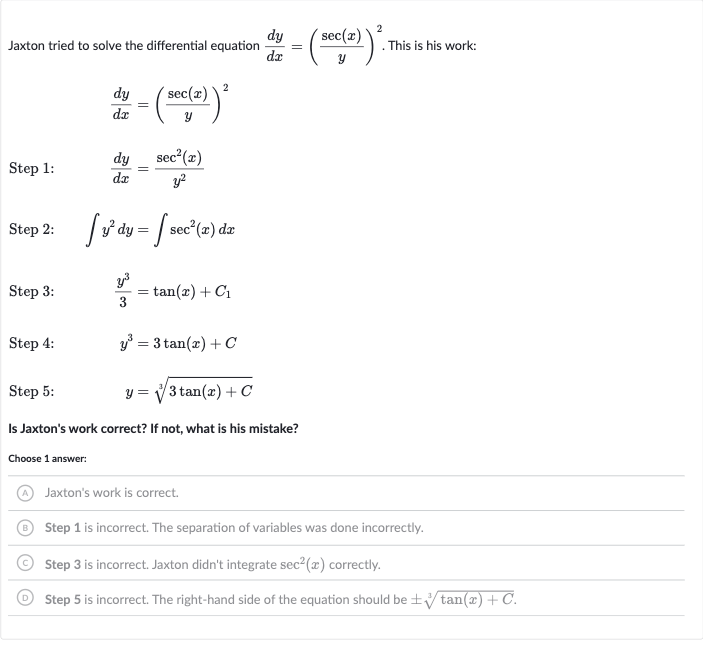AI tutor
Welcome to Bytelearn!
Let’s check out your problem:

Jaxton tried to solve the differential equation . This is his work:Step : Step : Step : Step : Step : Is Jaxton's work correct? If not, what is his mistake?Choose answer:(A) Jaxton's work is correct.(B) Step is incorrect. The separation of variables was done incorrectly.(C) Step is incorrect. Jaxton didn't integrate correctly.(D) Step is incorrect. The right-hand side of the equation should be .
Full solution
Q. Jaxton tried to solve the differential equation . This is his work:Step : Step : Step : Step : Step : Is Jaxton's work correct? If not, what is his mistake?Choose answer:(A) Jaxton's work is correct.(B) Step is incorrect. The separation of variables was done incorrectly.(C) Step is incorrect. Jaxton didn't integrate correctly.(D) Step is incorrect. The right-hand side of the equation should be .
- Restating the Problem: Jaxton starts by rewriting the differential equation as follows:This step is just a restatement of the problem and does not involve any mathematical operations.
- Separating Variables: Jaxton attempts to separate variables by moving all terms to one side and all terms to the other side:To separate variables, he should multiply both sides by and respectively:This is the correct method for separating variables in a differential equation.
- Integrating Both Sides: Jaxton integrates both sides of the equation:The integral of with respect to is , where is the constant of integration.The integral of with respect to is , where is another constant of integration.Jaxton's integration on the left side is correct, but he only writes one constant of integration on the right side. He should have two constants, one for each side of the equation, which can be combined into a single constant later.
- Writing Integrated Equation: Jaxton writes the integrated equation as:He should have written:Then, he can combine the constants and into a single constant :This step is correct, but he should acknowledge that represents the combination of two constants of integration.
- Solving for y: Jaxton solves for y by taking the cube root of both sides:This is incorrect because he multiplied the constant by when taking the cube root. The correct step should be:This is because when you take the cube root of a sum, you cannot distribute the cube root across the sum. Also, the cube root function allows for both positive and negative results, hence the sign.
